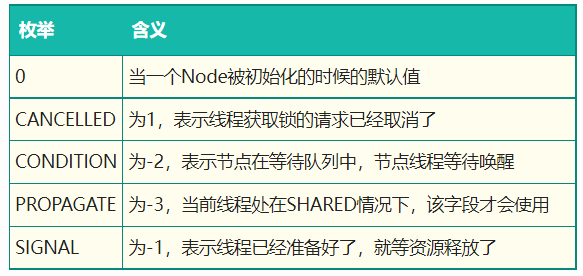ReentrantLock原理学习
ReentrantLock 实际上是基于 AbstractQueuedSynchronizer实现的可重入锁。在阅读了美团技术博客的相关文章后,对 ReentrantLock 以及 AQS 有了更深入的理解,这里梳理自己的思路,记录自己的学习经验。
AQS 简要原理
核心为由 volatile 修饰的 int 变量 state 和 CLH 等待队列
state 变量用来维护状态,一般非共享锁用0表示空闲,1表示已被占有,若已被占有时还有线程来请求,则加入 CLH 等待队列。
CLH等待队列其实是一个双向链表,存储的元素为 AQS 的内部类 Node,其中一些方法和属性(摘自美团博客):




lock() 的流程
ReentrantLock 中 lock() 方法的源码。
public void lock() {
sync.acquire(1);
}
sync 是 ReentrantLock 中的内部类 Sync 的对象, 其又分为公平和非公平,代表着公平锁和非公平锁。

而 acquire() 方法继承自 AQS
public final void acquire(int arg) {
if (!tryAcquire(arg) &&
acquireQueued(addWaiter(Node.EXCLUSIVE), arg))
selfInterrupt();
}
首先判断 tryAcquire(arg) 是否成功, tryAcquire() 方法由 Sync子类重写,看一下非公平锁的实现:
protected final boolean tryAcquire(int acquires) {
return nonfairTryAcquire(acquires);
}
@ReservedStackAccess
final boolean nonfairTryAcquire(int acquires) {
final Thread current = Thread.currentThread();
int c = getState();
if (c == 0) {
// 若state为0,尝试CAS将state置为1
if (compareAndSetState(0, acquires)) {
//将占有锁的线程设为当前线程,AbstractOwnableSynchronizer中成员变量
//private transient Thread exclusiveOwnerThread;
setExclusiveOwnerThread(current);
return true;
}
}
else if (current == getExclusiveOwnerThread()) {
//可重入,重入一次+1
int nextc = c + acquires;
if (nextc < 0) // overflow
throw new Error("Maximum lock count exceeded");
setState(nextc);
return true;
}
return false;
}
若 tryAcquire() 成功, 则成功获取锁,否则执行 acquireQueued(addWaiter(Node.EXCLUSIVE), arg)方法。
先看 addWaiter() 方法,返回一个 Node。
private Node addWaiter(Node mode) {
//构造方法中会把Node中thread置为当前线程
Node node = new Node(mode);
for (;;) {
Node oldTail = tail;
if (oldTail != null) {
node.setPrevRelaxed(oldTail);
//将新节点置为tail.
if (compareAndSetTail(oldTail, node)) {
oldTail.next = node;
return node;
}
} else {
//队列还未初始化,则初始化队列
initializeSyncQueue();
}
}
}
private final void initializeSyncQueue() {
Node h;
if (HEAD.compareAndSet(this, null, (h = new Node())))
tail = h;
//创建一个空节点,作为虚拟头部
}
再看 acquireQueued(final Node node,int arg)方法
final boolean acquireQueued(final Node node, int arg) {
boolean interrupted = false;
try {
for (;;) {
final Node p = node.predecessor();
if (p == head && tryAcquire(arg)) {
setHead(node);
p.next = null; // help GC
return interrupted;
}
if (shouldParkAfterFailedAcquire(p, node))
interrupted |= parkAndCheckInterrupt();
}
} catch (Throwable t) {
cancelAcquire(node);
if (interrupted)
selfInterrupt();
throw t;
}
}
不断自旋尝试获取锁,为避免长期自旋,还会在循环中检测是否需要阻塞。
若当前节点前驱节点为 head (空节点作虚拟头部),说明当前节点已为队列中最前的节点,执行 tryAcquire() 方法,成功则将当前节点设为头节点。之后会判断当前节点是否需要阻塞,源码如下,自旋重复上述操作。
检查是否需要阻塞。若前一个节点状态已经为 SIGNAL 返回 true, 若前一个节点被取消,则不断往前找到第一个非取消的节点与当前 node 互连, 否则尝试通过 CAS 将前一节点等待状态设为 SIGNAL。
private static boolean shouldParkAfterFailedAcquire(Node pred, Node node) {
int ws = pred.waitStatus;
if (ws == Node.SIGNAL)
/*
* This node has already set status asking a release
* to signal it, so it can safely park.
*/
return true;
if (ws > 0) {
/*
* Predecessor was cancelled. Skip over predecessors and
* indicate retry.
*/
do {
node.prev = pred = pred.prev;
} while (pred.waitStatus > 0);
pred.next = node;
} else {
/*
* waitStatus must be 0 or PROPAGATE. Indicate that we
* need a signal, but don't park yet. Caller will need to
* retry to make sure it cannot acquire before parking.
*/
pred.compareAndSetWaitStatus(ws, Node.SIGNAL);
}
return false;
}
若抛出异常则执行 cancelAcquire() 方法。
private void cancelAcquire(Node node) {
// Ignore if node doesn't exist
if (node == null)
return;
node.thread = null;
// Skip cancelled predecessors
Node pred = node.prev;
while (pred.waitStatus > 0)
node.prev = pred = pred.prev;
// predNext is the apparent node to unsplice. CASes below will
// fail if not, in which case, we lost race vs another cancel
// or signal, so no further action is necessary, although with
// a possibility that a cancelled node may transiently remain
// reachable.
Node predNext = pred.next;
// Can use unconditional write instead of CAS here.
// After this atomic step, other Nodes can skip past us.
// Before, we are free of interference from other threads.
node.waitStatus = Node.CANCELLED;
// If we are the tail, remove ourselves.
if (node == tail && compareAndSetTail(node, pred)) {
pred.compareAndSetNext(predNext, null);
} else {
// If successor needs signal, try to set pred's next-link
// so it will get one. Otherwise wake it up to propagate.
int ws;
if (pred != head &&
((ws = pred.waitStatus) == Node.SIGNAL ||
(ws <= 0 && pred.compareAndSetWaitStatus(ws, Node.SIGNAL))) &&
pred.thread != null) {
Node next = node.next;
if (next != null && next.waitStatus <= 0)
pred.compareAndSetNext(predNext, next);
} else {
unparkSuccessor(node);
}
node.next = node; // help GC
}
}
回到 acquire() 方法通过返回值判断线程是否被中断,是则将线程中断。
unlock() 流程
public final boolean release(int arg) {
if (tryRelease(arg)) {
Node h = head;
if (h != null && h.waitStatus != 0)
unparkSuccessor(h);
return true;
}
return false;
}
// Sync类重写
protected final boolean tryRelease(int releases) {
//考虑可重入
int c = getState() - releases;
if (Thread.currentThread() != getExclusiveOwnerThread())
throw new IllegalMonitorStateException();
boolean free = false;
//为0则释放锁
if (c == 0) {
free = true;
setExclusiveOwnerThread(null);
}
setState(c);
return free;
}
先尝试 tryRelease() 方法,若可重入锁完全释放,判断后继节点是否需要释放,需要则释放 head 节点的后继节点(即解除后继节点维护的线程阻塞)。
private void unparkSuccessor(Node node) {
/*
* If status is negative (i.e., possibly needing signal) try
* to clear in anticipation of signalling. It is OK if this
* fails or if status is changed by waiting thread.
*/
int ws = node.waitStatus;
if (ws < 0)
node.compareAndSetWaitStatus(ws, 0);
/*
* Thread to unpark is held in successor, which is normally
* just the next node. But if cancelled or apparently null,
* traverse backwards from tail to find the actual
* non-cancelled successor.
找到第一个未取消的节点
*/
Node s = node.next;
if (s == null || s.waitStatus > 0) {
s = null;
for (Node p = tail; p != node && p != null; p = p.prev)
if (p.waitStatus <= 0)
s = p;
}
if (s != null)
LockSupport.unpark(s.thread);
}
tryLock(long timeout, TimeUnit unit)流程
public boolean tryLock(long timeout, TimeUnit unit)
throws InterruptedException {
return sync.tryAcquireNanos(1, unit.toNanos(timeout));
}
public final boolean tryAcquireNanos(int arg, long nanosTimeout)
throws InterruptedException {
if (Thread.interrupted())
throw new InterruptedException();
return tryAcquire(arg) ||
doAcquireNanos(arg, nanosTimeout);
}
private boolean doAcquireNanos(int arg, long nanosTimeout)
throws InterruptedException {
if (nanosTimeout <= 0L)
return false;
final long deadline = System.nanoTime() + nanosTimeout;
final Node node = addWaiter(Node.EXCLUSIVE);
try {
for (;;) {
final Node p = node.predecessor();
if (p == head && tryAcquire(arg)) {
setHead(node);
p.next = null; // help GC
return true;
}
nanosTimeout = deadline - System.nanoTime();
//超时则不再尝试
if (nanosTimeout <= 0L) {
cancelAcquire(node);
return false;
}
if (shouldParkAfterFailedAcquire(p, node) &&
nanosTimeout > SPIN_FOR_TIMEOUT_THRESHOLD)
LockSupport.parkNanos(this, nanosTimeout);
if (Thread.interrupted())
throw new InterruptedException();
}
} catch (Throwable t) {
cancelAcquire(node);
throw t;
}
}
大概就是尝试自旋执行 tryAcquire(), 超时则取消。
